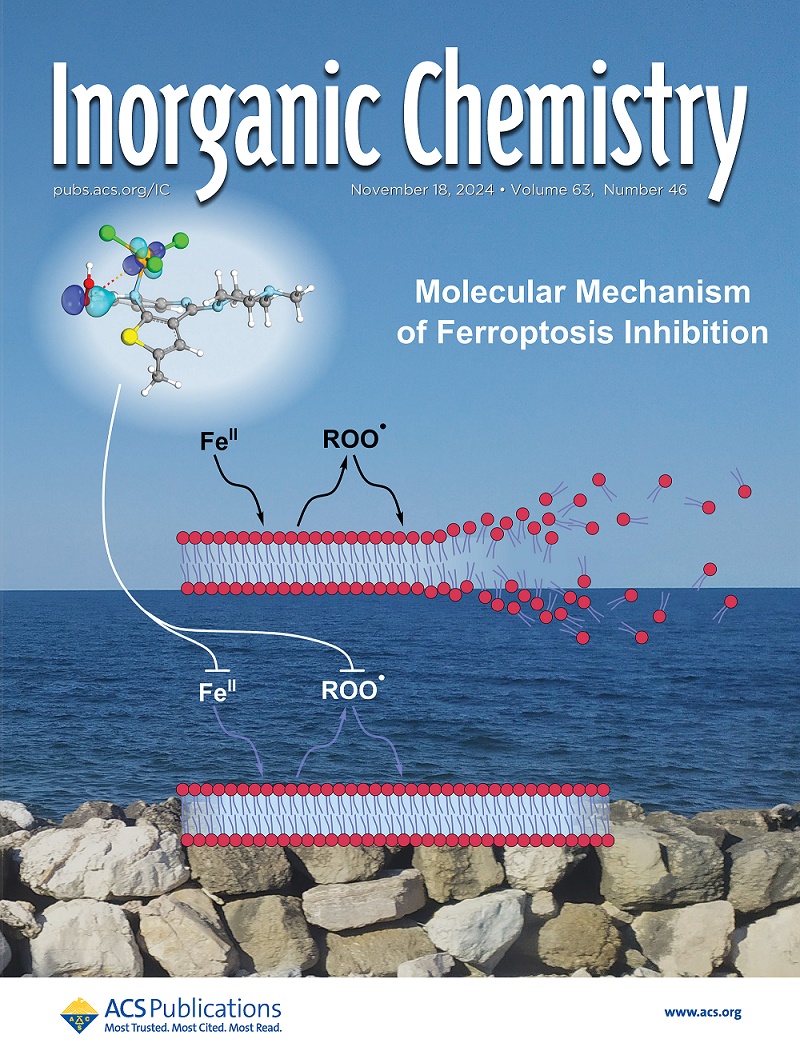卤素取代基调控Ca(II)基发光HOFs生成的活性氧类型及其智能传感和光动力灭菌。
IF 4.7
2区 化学
Q1 CHEMISTRY, INORGANIC & NUCLEAR
引用次数: 0
摘要
氢键有机骨架在离子传感和光动力杀菌等领域具有独特的应用优势。本文采用不同重原子取代基的8-羟基喹啉与Ca(NO3)2·4H2O反应,得到了4个羟基喹啉。ca - hof对SO42-离子具有优异的智能传感性能,检测限分别为3.45、2.15、2.29和1.34 μM。此外,ca - hof / 1/3/4对Cr2O72-离子也表现出高度敏感的传感性能,其检出限分别为0.833、1.72和1.11 μM。值得注意的是,通过调节配体上的重原子取代基,可以很容易地实现ca - hof中活性氧(ROS)的光驱动开关。含有- cl取代的Ca-HOF-1和Ca-HOF-2在光照射条件下只能高效生成II型ROS- 1o2,而含有- br或-I取代的Ca-HOF-3和Ca-HOF-4在光照射条件下只能高效生成I型ROS-•OH。据我们所知,这是第一次通过改变重卤素原子取代基来调节光照射条件下HOF光敏剂中不同类型ROS的生成。这项工作不仅为光敏剂调控特异性ROS的产生打开了大门,而且促进了高效hof光敏剂的开发。本文章由计算机程序翻译,如有差异,请以英文原文为准。
Halogen Substituents Regulate the Types of Reactive Oxygen Species Generated by Ca(II)-Based Luminescent HOFs, and Their Smart Sensing and Photodynamic Sterilization.
Hydrogen-bonded organic frameworks (HOFs) have demonstrated unique application advantages in fields such as ion sensing and photodynamic sterilization. Herein, four HOFs were obtained by using 8-hydroxyquinoline with different heavy atom substituents to react with Ca(NO3)2·4H2O. Ca-HOFs all have excellent smart sensing performance behavior to SO42- ions, and their detection limits are 3.45, 2.15, 2.29, and 1.34 μM, respectively. In addition, Ca-HOF-1/3/4 also exhibits highly sensitive sensing performance behavior to Cr2O72- ions, and their detection limits are 0.833, 1.72, and 1.11 μM, respectively. Notably, light-driven switching of reactive oxygen species (ROS) in Ca-HOFs can be easily achieved by regulating the heavy atom substituents on the ligands. Ca-HOF-1 and Ca-HOF-2 containing -Cl substitution only efficiently produce type II ROS-1O2 under light irradiation conditions, while Ca-HOF-3 and Ca-HOF-4 containing -Br or -I substitution only produce type I ROS-•OH under light irradiation conditions. To the best of our knowledge, this is the first time that the generation of different types of ROS in HOF photosensitizers under light irradiation conditions has been regulated by changing the halogen-heavy atom substituents. This work not only opens a door for regulating the generation of specific ROS by photosensitizers but also promotes the development of efficient HOF-based photosensitizers.
求助全文
通过发布文献求助,成功后即可免费获取论文全文。
去求助
来源期刊

Inorganic Chemistry
化学-无机化学与核化学
CiteScore
7.60
自引率
13.00%
发文量
1960
审稿时长
1.9 months
期刊介绍:
Inorganic Chemistry publishes fundamental studies in all phases of inorganic chemistry. Coverage includes experimental and theoretical reports on quantitative studies of structure and thermodynamics, kinetics, mechanisms of inorganic reactions, bioinorganic chemistry, and relevant aspects of organometallic chemistry, solid-state phenomena, and chemical bonding theory. Emphasis is placed on the synthesis, structure, thermodynamics, reactivity, spectroscopy, and bonding properties of significant new and known compounds.
 求助内容:
求助内容: 应助结果提醒方式:
应助结果提醒方式:


